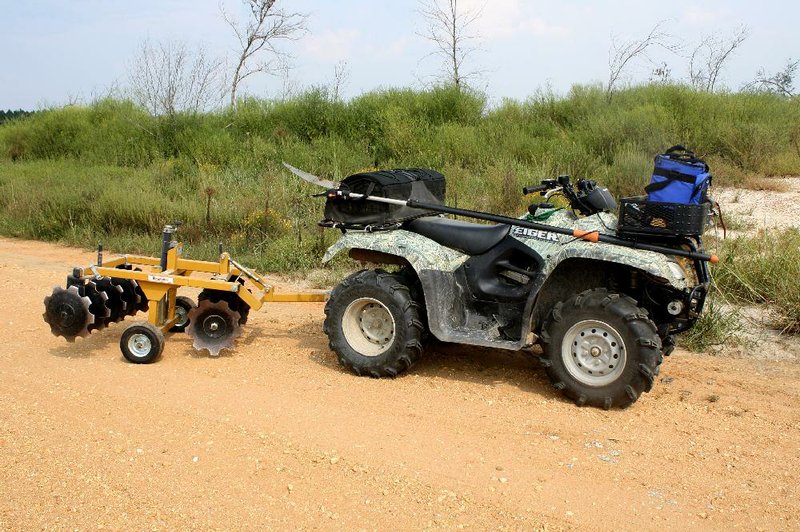Many deer hunters wait until late summer to do the chores that keep their hunting areas in prime condition, but now is the best time to work in the woods.
It's more pleasant to work outside in cold weather than in the double- or triple-digit heat of summer, and you won't disturb deer as much as you will if you make a commotion nearer to the hunting season.
Trimming
Trees and bushes have grown over the years and encroached on some of my shooting lanes. It's been so gradual that I didn't consider it worthy of my attention until last season.
Over the last four years, the vista over some of my lanes has decreased as much as 30 percent. Branches stretch over lanes and inhibit sight lines to such a degree that I have to lean to shoot around protruding obstacles. In some places they are so intrusive that they could interfere with a shot.
Smaller lanes have closed in entirely and turned multi-dimensional stands into decidedly one-dimensional affairs.
I could trim back lane edges and reopen trails in August, when the temperature is in the high 90s and the humidity is at least 70 percent. Right about the time I get into a working rhythm is when a horsefly or two will make me feel as if I've been stabbed. In March, they're still safely tucked away in their special corner of hell.
Winter is also a good time for trimming because trees and shrubs are bare. That gives you a more accurate view of the woods and a more intuitive feel of what you need to clear. Thickets that seem impenetrable during the green seasons reveal the best and easiest routes for pruning and thinning.
You don't have to cut much, really. You only need to remove saplings and sprigs that clog established trails, and trim away branches that hang over shooting lanes.
My favorite tool for most of this work is a Fiskars cam-operated lopper. It's quiet, fast and it snips surprisingly thick wood. I also use a Fiskars manual pole saw with a pull-cable cutter.
For bigger jobs, I use a Poulan Pro gas-powered pole saw and a Stihl Farm Boss with a 14-inch bar.
When you're done, throw your cuttings into piles. You can hunt rabbits near them later.
If you lease hunting land or belong to a club that leases land, make sure what measure of cutting your club rules allow or prohibit.
Food plots
I used to wait until summer to work my food plots, but now is the better time to work the soil.
We don't have large open areas for food plots on my club, so I take advantage of openings in recently thinned pine plantations. A disc harrow that I can pull with my four-wheeler is ideal for working the ground in these narrow confines.
Many ATV discs are available in any price range. I use a King Kutter ATV Compact Disc. It has a narrow turn radius, and I can also maneuver it around the pine stumps that remain in the rows.
The Ground Hog Max is a tiny harrow that attaches directly to the hitch receiver on your ATV. It doesn't have wheels, and it is narrower than an ATV, so its turning radius is much narrower than a pull-behind disc. It seems expensive for no more than you get, but those who use it swear by it.
After turning the soil, I apply a generous amount of lime.
I've tried various seed mixes, but I've had the best success with Pennington's Rackmaster Elite. It contains a mixture of red and white clovers, chicory, rye, rape, wheat, oats and greens. The clover has been especially resilient and has maintained a permanent presence.
I was very surprised last year that deer did not use my most established food plot. After they ate all the acorns, I expected them to hit the plot hard after the first freeze. But they didn't bother it in 2014 or in early January. I'll keep it going because cultivating food for wildlife satisfies my "inner farmer."
Repair stands
Now is also a good time to repair aging stands.
Most hunters use metal frame stands with metal ladders, but there are still a lot of wooden box stands with wooden steps and ladders in service. Wooden steps and rungs rot and create safety hazards. Replace soft ones now to prevent mishaps in the fall.
Water damage can destabilize the wooden floors inside as well. Carpeted floors are especially vulnerable because carpet holds moisture. If the carpet is soggy, replace it. Test your floors for soft spots and replace if necessary.
Replace or repair tower stand siding, and also remove overgrown brush from around your stands.
Plants will grow a lot over the spring and summer, so you'll probably have to do some light cutting later. Since you did the bulk of the job in the winter, you can get in and out with minor disturbance.
While you're at it, keep an eye out for wild turkeys. The best time to scout for gobblers is when you're working at something else.
Sports on 03/01/2015

